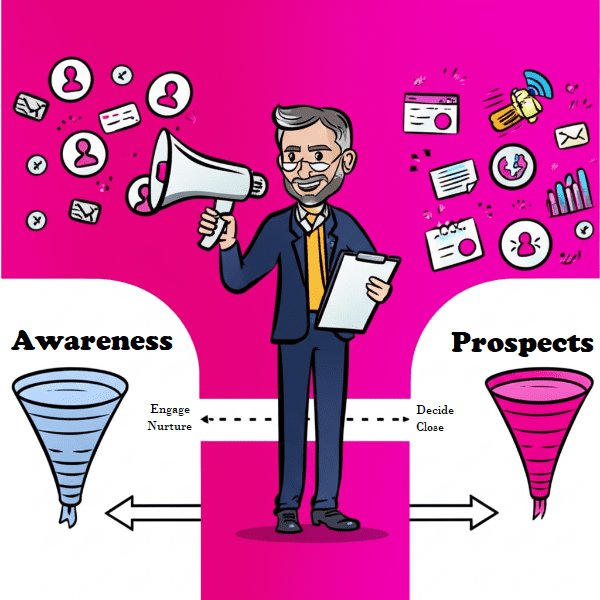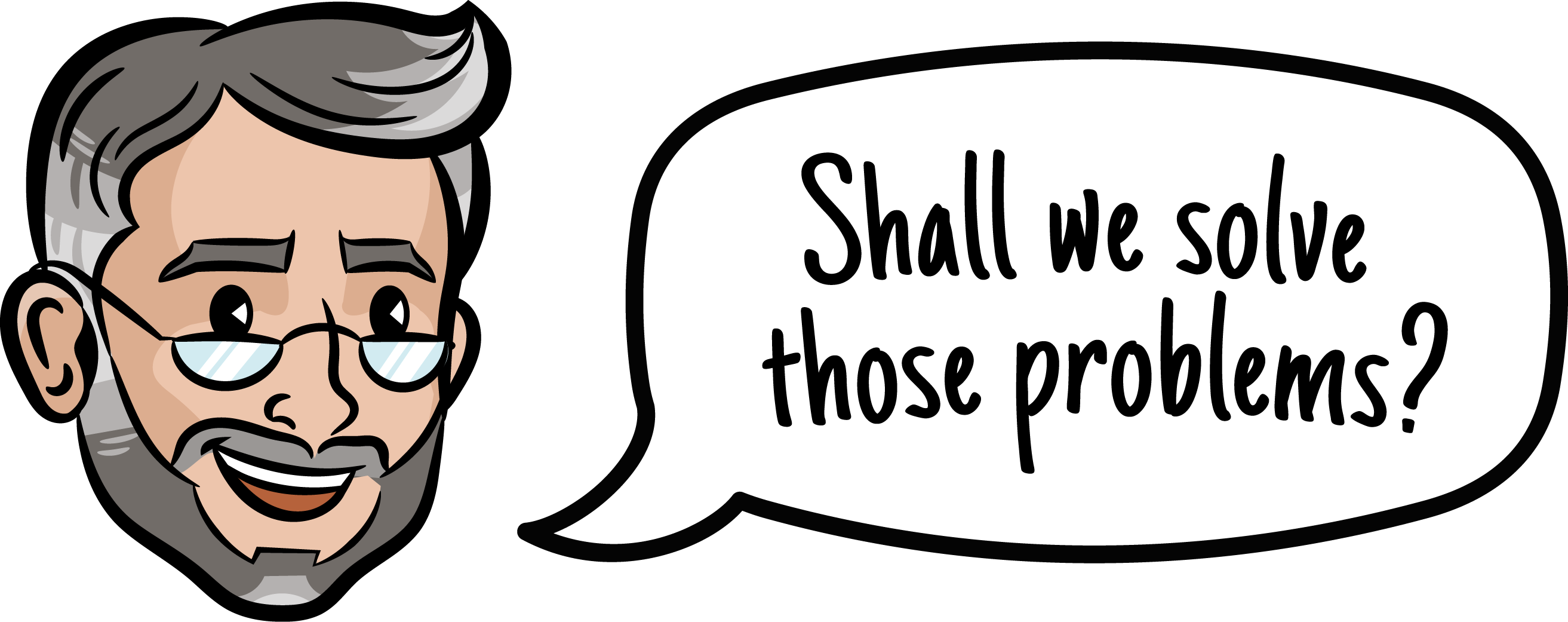Table of Contents
Understanding the Sales Funnel vs. Marketing Funnel: A Foundation for Growth
What is the Marketing Funnel? Definition and Stages
What is the Sales Funnel? Definition and Stages
Key Differences and Critical Overlaps
The Imperative of Sales-Marketing Alignment
Strategies for Achieving Sales-Marketing Alignment
The Unified Funnel: A Seamless Customer Journey (Full Funnel Strategy)
Measuring the Success of Alignment
Conclusion: Driving Revenue Through Collaboration
Useful Related Posts from Sales Funnel Professor
What’s the difference between a marketing funnel vs sales funnel? It’s a question that sits at the heart of many internal frustrations. Marketing teams generate leads through campaigns and content. Sales teams wait for qualified leads, ready to close deals. Yet, somewhere in between, leads fall through the cracks. Sales doubts lead quality. Marketing questions follow-up speed. Tension builds—despite both teams aiming for the same outcome: revenue growth.
This disconnect often stems from viewing the marketing funnel and sales funnel as separate silos rather than as stages of a unified customer journey. In reality, true success comes when both funnels align—ensuring leads flow smoothly from awareness to conversion.
In this article, we break down the differences between the marketing funnel and the sales funnel, uncover where they overlap, and show why alignment isn’t optional—it’s essential for unlocking revenue, boosting lead quality, and shortening your sales cycle.

Understanding the Sales Funnel vs. Marketing Funnel: A Foundation for Growth
The common challenge for many organizations is a perceived chasm between marketing and sales. Marketing focuses on the top-of-funnel activities – building brand awareness, attracting visitors, generating leads. Sales focuses on the bottom-of-funnel activities – qualifying prospects, closing deals, driving immediate revenue. While their activities differ, their ultimate objective is shared: sustainable business growth fueled by customer acquisition and retention.
Think of the journey a potential customer takes from hearing about your company for the first time to becoming a paying customer. This journey isn’t a series of isolated events; it’s a continuum. The traditional marketing funnel and sales funnel are simply models we use to understand and manage different phases of this continuum. Seeing them as interconnected parts of a larger customer journey, rather than separate entities, is foundational to achieving strategic alignment.
This article aims to clearly define the differences and identify the overlaps between these two vital models. Our core focus, however, is on the absolute necessity of aligning them. For marketing and sales leaders wrestling with issues like inconsistent lead quality, slow lead handoff process, or internal departmental friction, understanding this alignment is the key to unlocking more efficient processes, faster conversions, and ultimately, greater revenue growth.
What is the Marketing Funnel? Definition and Stages
From a marketing perspective, the marketing funnel is a model that illustrates the journey of a potential customer from initial awareness of a brand or product to expressing enough interest to become a lead. Its primary goal is to attract a broad audience and nurture their interest, educating them and building trust until they are ready for a more direct engagement, typically with the sales team.
The marketing funnel is fundamentally about lead generation and initial lead nurturing. Marketing activities at each stage are designed to engage potential customers based on their level of awareness and interest.
Common Stages of the Marketing Funnel:
The marketing funnel maps the journey from initial awareness to sales readiness. It’s typically divided into three stages:
1. Awareness (Top of Funnel – TOFU)
At this stage, the goal is to attract attention and introduce your brand. Potential customers may not yet be actively searching but are experiencing a problem you can solve.
Key activities:
- Content marketing (blogs, videos, infographics)
- SEO to capture informational searches
- Social media engagement
- Paid advertising to reach broad audiences
Key metrics: Traffic, reach, content engagement.
2. Consideration (Middle of Funnel – MOFU)
Leads are now aware of their needs and exploring possible solutions. Your goal is to educate and build trust by positioning your brand as a credible choice.
Key activities:
- Webinars and workshops
- eBooks, guides, and whitepapers
- Email nurturing campaigns
- Retargeting ads
Key metrics: Lead conversion rate, email engagement, gated content downloads.
3. Evaluation (Bottom of Funnel – BOFU)
Here, leads are comparing solutions and evaluating vendors. Marketing should qualify and prepare them for handoff to sales.
Key activities:
- Product comparisons and case studies
- Testimonials, free trials, and demos
- One-on-one consultations
Key metrics: Demo requests, trial sign-ups, MQL volume.
This funnel ensures you’re not just attracting attention but guiding prospects toward becoming qualified leads, ready for your sales team to close.
What is the Sales Funnel? Definition and Stages
Where the marketing funnel focuses on attracting and nurturing leads up to the point of sales readiness, the sales funnel takes over to convert those qualified leads into paying customers. From a sales perspective, the sales funnel is a step-by-step process that tracks the journey of a prospect from initial contact (often an MQL from marketing) through various stages of the sales process, ultimately leading to a closed deal.
The primary goal of the sales funnel is conversion. Sales activities are highly personalized and focused on building a direct relationship with the prospect, understanding their specific needs in detail, and demonstrating how your solution directly addresses those needs, overcoming objections along the way.
Common Stages of the Sales Funnel:
The sales funnel guides qualified leads through key decision-making stages, aiming to turn interest into revenue. It generally includes four main stages:
1. Prospecting / Qualification
Sales begins by engaging Marketing Qualified Leads (MQLs) to assess their fit. This involves confirming key criteria such as budget, authority, need, and timeline (BANT).
Key activities:
- Outreach via calls, emails, or social platforms
- Discovery calls to understand pain points and goals
- Needs assessment for solution fit
Key metrics: Contact rate, discovery call completion, MQL-to-SQL conversion.
2. Proposal / Presentation
Once qualified as Sales Qualified Leads (SQLs), prospects receive a tailored proposal that addresses their unique challenges and objectives.
Key activities:
- Customized proposals and ROI projections
- Personalized demos or presentations
- Sharing supporting resources (e.g., case studies, data)
Key metrics: Proposal acceptance rate, demo engagement.
3. Negotiation / Objections
This phase tackles pricing, contract terms, or other concerns. Sales works to build trust and reach a win-win agreement.
Key activities:
- Listening and clarifying objections
- Offering evidence-based responses
- Negotiating mutually acceptable terms
Key metrics: Objection resolution rate, negotiation-to-close ratio.
4. Closing
The final step is converting the SQL into a paying customer.
Key activities:
- Finalizing contracts
- Supporting the signing process
- Initiating onboarding or implementation
Key metrics: Closing rate, average sales cycle length.
While marketing fills the funnel, sales drives conversion by building relationships and delivering solutions that match buyer needs.
Key Differences and Critical Overlaps
Comparing the marketing and sales funnels reveals their distinct purposes and methods:
- Perspective: Marketing typically adopts a broader, audience-centric perspective, focusing on segments or personas. Sales takes a narrower, individual-centric perspective, focusing on specific companies and contacts.
- Goals: Marketing’s primary goal is lead generation and nurturing interest up to a point of sales readiness (MQLs). Sales’ primary goal is revenue generation through converting qualified leads into paying customers (closing deals).
- Tactics: Marketing uses tactics designed for broad reach and engagement (content, SEO, social media, advertising, mass email). Sales uses tactics for personalized, one-to-one interaction (calls, personalized emails, tailored presentations, demos, negotiation).
- Timeline Focus: Marketing operates on a longer timeline, building awareness and nurturing relationships over potentially weeks or months before a lead is ready for sales. Sales operates on a shorter, more immediate timeline, focusing on moving qualified leads through the closing process as efficiently as possible.
Despite these differences, there is a critical overlap: the point where the marketing funnel ends and the sales funnel begins. This is the lead handoff.
Understanding this critical juncture and the distinct roles leading up to it is essential before attempting to align the two functions. Misunderstandings about what each team is responsible for at this overlap point are a major source of friction.
The Imperative of Sales-Marketing Alignment
When marketing and sales operate in silos, revenue suffers. Misalignment often shows up as marketing hitting MQL targets while sales questions lead quality. Sales wants leads, but marketing feels they’re ignored. Interested prospects drop off after handoff. Valuable data stays trapped within departments. The result? Finger-pointing, frustration, and wasted potential.
This disconnect comes at a high cost:
- Wasted Spend: Leads not followed up mean lost ROI.
- Missed Revenue: High-potential leads fall through the cracks.
- Inefficient Operations: Time is spent on low-converting activities.
- Poor Customer Experience: Inconsistent messaging causes friction.
- Slower Growth: Misalignment limits scalability and momentum.
On the flip side, strong sales-marketing alignment drives performance:
- Better Lead Quality & Conversions: Shared definitions ensure sales gets leads they trust—and can close.
- Faster Sales Cycles: Seamless handoffs reduce friction and delays.
- Higher ROI: More revenue from fewer leads improves marketing efficiency.
- Improved Customer Experience: Consistency builds trust across the buyer journey.
- Stronger Team Morale: Shared goals and mutual respect boost collaboration.
Alignment isn’t a minor fix—it’s a strategic necessity. By working toward shared revenue goals, clarifying lead definitions, and collaborating on key processes, marketing and sales can unlock faster growth and more predictable outcomes.
The future of growth isn’t in silos. It’s in synergy.
Strategies for Achieving Sales-Marketing Alignment
Bridging the gap between marketing and sales requires proactive strategies focused on collaboration, shared understanding, and integrated processes.
Establishing Shared Goals and Definitions
One of the foundational issues in misalignment is often differing objectives and terminology. Marketing might be measured purely on MQL volume, while sales is measured on closed deals. This can create conflict (Marketing sending potentially lower-quality leads to hit volume targets, Sales rejecting leads that don’t immediately fit their ideal).
The solution is to move beyond departmental KPIs to unified business objectives. Both teams should have shared goals tied directly to revenue growth, customer acquisition cost (CAC), or customer lifetime value (CLTV). This aligns incentives and ensures everyone is working towards the same destination.
Crucially, agree on common definitions. What exactly constitutes a “lead” at each stage? What are the specific, agreed-upon criteria for a Marketing Qualified Lead (MQL)? What distinguishes an MQL from a Sales Qualified Lead (SQL)? Establishing clear, documented definitions that both teams agree on is paramount. This clarity reduces ambiguity and ensures that when marketing passes an MQL, sales knows exactly what to expect, and when sales provides feedback, marketing understands the criteria.
Improving Communication and Collaboration
Silos thrive in the absence of communication. Regular, structured interaction between marketing and sales teams is vital.
- Regular joint meetings: Hold weekly or bi-weekly meetings involving representatives from both teams. Use this time to discuss pipeline status, review lead quality, share insights from customer interactions, and plan upcoming campaigns or sales initiatives.
- Creating feedback loops: Establish formal mechanisms for sales to provide feedback on the quality and readiness of MQLs they receive. Similarly, marketing should share insights from campaign performance and lead engagement data with sales. This continuous feedback loop allows marketing to refine its targeting and nurturing and sales to understand the context behind the leads they receive.
- Encouraging empathy and understanding: Foster an environment where team members take the time to understand each other’s daily realities, challenges, and successes. Shadowing sales calls or having marketing team members participate in sales pipeline reviews can build valuable empathy and a shared perspective.
Streamlining the Lead Handoff Process
The moment a lead transitions from marketing’s responsibility to sales’ is perhaps the most critical point of integration. A clunky, undefined lead handoff process is a primary source of friction.
- Defining exact handoff criteria: Building on the shared definitions of MQL and SQL, define the precise conditions under which an MQL is officially “handed off” to sales. This should include both demographic/firmographic criteria (e.g., company size, industry, job title) and behavioral criteria (e.g., downloaded specific content, attended a webinar, visited key product pages).
- Implementing Service Level Agreements (SLAs): Formal SLAs between marketing and sales set clear expectations and accountability.
- Marketing’s SLA: Specifies the quantity and quality of MQLs marketing commits to delivering to sales within a given period.
- Sales’ SLA: Specifies how quickly sales commits to following up on MQLs once received (e.g., within 24 business hours) and the actions they will take (e.g., attempting contact multiple times).
- SLAs create mutual accountability and ensure leads don’t languish in the handoff zone.
- Developing a clear, documented procedure: Outline the step-by-step process for the handoff. Who is responsible for what? What information is included? How is the lead status updated in the CRM? A documented procedure ensures consistency and transparency.
Implementing Effective Lead Scoring and Qualification
A robust, collaboratively developed lead scoring model is a powerful tool for alignment and improving lead quality. Instead of marketing guessing which leads are hot, and sales sorting through masses, a shared scoring system prioritizes leads based on their likelihood to buy.
- Collaborative lead scoring model: Marketing and sales should build the lead scoring model together. Marketing brings data on engagement behaviors (website visits, content downloads, email clicks). Sales brings insights on which lead characteristics and behaviors actually correlate with closed deals (job title, industry, specific questions asked, responses during discovery calls).
- Ensuring sales agrees on factors: Sales must agree on the weighting and factors in the scoring system. Their buy-in is essential for trusting the scores and prioritizing leads accordingly.
- Using lead scoring to prioritize follow-up: High-scoring leads (those who meet both demographic and behavioral criteria) are typically designated as MQLs and are prioritized for immediate sales follow-up according to the SLA. Leads with lower scores can be automatically routed back into marketing nurturing sequences.
Leveraging Technology and Data for Integration
Technology is a key enabler of sales marketing alignment. The right tools, integrated effectively, can break down data silos and provide a single source of truth about the customer journey.
- Integrate CRM & Marketing Automation Tools
- Align systems like Salesforce or HubSpot (for sales) with platforms like Marketo or HubSpot Marketing Hub (for marketing) to ensure a shared view of the customer journey.
- Enable Real-Time Data Sync
- Automatically share lead activity (e.g., downloads, page visits) across systems. When sales updates lead status, marketing can adjust automation accordingly. Tools like Zapier help streamline this process.
- Use Shared Dashboards and Metrics
- Provide both teams access to the same performance data—MQL-to-SQL rates, lead response times, and close rates—so they can collaborate on improving funnel performance.
- Drive Smarter Handoffs and Strategy
- Unified data helps prioritize qualified leads, optimize follow-up timing, and continuously refine scoring models and campaign strategy.
Leveraging an integrated technology stack empowers both teams with the information they need to work effectively together and provides leadership with the data to monitor and improve alignment.
The Unified Funnel: A Seamless Customer Journey (Full Funnel Strategy)
Moving beyond viewing separate funnels towards a full funnel strategy means recognizing that the customer journey is a continuous flow. While the lead handoff process is a critical point of collaboration, the collaboration shouldn’t stop there. A truly aligned approach involves marketing and sales working together across the entire journey.
This isn’t just about passing a lead baton; it’s about a relay race where both runners are coordinating their pace and passing smoothly, and then the first runner cheers on the second, ready to jump back in if needed (e.g., if a deal is lost and needs re-nurturing).
- Collaboration beyond handoff:
- Marketing supporting sales post-handoff: Marketing can continue to provide valuable support once a lead is in the sales pipeline. This might include creating specific content tailored for later-stage sales cycles (e.g., competitive comparison guides, ROI calculators), providing sales enablement materials, or even running targeted advertising campaigns to reinforce messaging for active opportunities.
- Sales informing marketing strategy: Sales teams are on the front lines, gathering invaluable insights about customer needs, common objections, and the messaging that resonates. This feedback is crucial for marketing to refine its targeting, messaging, and content strategy for earlier funnel stages. Regular meetings where sales shares these insights directly with marketing are vital.
This integrated view is the essence of a full funnel strategy. It acknowledges that customer acquisition and retention are shared responsibilities that span traditional departmental lines. It also aligns with the growing trend towards “Revenue Operations” (RevOps), a function that breaks down silos between marketing, sales, and customer success to create a unified, data-driven approach to revenue generation across the entire customer lifecycle.
Measuring the Success of Alignment
Measuring the impact of sales marketing alignment requires looking beyond individual team metrics. Success is measured by how effectively the unified funnel performs and how well the collaboration translates into business results.
Key Performance Indicators (KPIs) that reflect successful alignment include:
- MQL to SQL Conversion Rate: This directly measures the effectiveness of the lead handoff and sales’ ability to qualify leads provided by marketing. An increasing rate indicates better alignment on what constitutes a qualified lead.
- SQL to Customer Conversion Rate: While a core sales metric, improvements here can reflect better lead quality from marketing and a more seamless sales process.
- Sales Cycle Length: A shorter sales cycle for leads originating from aligned processes indicates efficiency in moving prospects through the pipeline after the handoff.
- Lead Response Time by Sales: Directly measures adherence to sales SLAs and the speed of follow-up on marketing-generated leads.
- Customer Acquisition Cost (CAC): Alignment reduces wasted effort, leading to more efficient lead conversion and potentially lowering the cost of acquiring a new customer.
- Customer Lifetime Value (CLTV): While influenced by post-sale activities, a positive initial customer experience driven by a seamless journey can contribute to higher CLTV.
- Revenue Growth Directly Attributable to Aligned Efforts: Tracking revenue generated from leads that flow through the aligned process is the ultimate measure of success.
Analyzing these metrics collaboratively provides both teams with insights into where the funnel is performing well and where bottlenecks or friction points still exist. Data-driven decision-making based on these shared metrics is crucial for continuous optimization of the aligned process.
Conclusion: Driving Revenue Through Collaboration
We’ve explored the distinct roles of the marketing funnel and the sales funnel, recognizing that marketing’s focus on attraction and nurturing leads seamlessly into sales’ focus on qualification and conversion. The critical takeaway is clear: these are not competing or independent processes, but two essential, interconnected phases of the customer journey.

For marketing and sales leaders facing challenges with lead quality, handoff friction, and achieving consistent revenue growth, sales marketing alignment is not merely a buzzword; it’s a strategic imperative. Achieving this alignment requires a commitment to shared goals, open communication, streamlined processes (especially the lead handoff process), collaborative use of technology and data, and the adoption of a full funnel strategy that sees the customer journey as a unified effort.
By prioritizing collaboration, building clear handoff procedures, leveraging integrated technology, and focusing on shared revenue objectives, your marketing and sales teams can move beyond perceived departmental differences to function as a powerful, cohesive unit. This not only resolves internal friction but also creates a smoother, more effective experience for your potential customers, leading directly to faster conversion rates and sustainable, predictable revenue growth.
Are you ready to break down the silos and build a truly unified revenue engine?
Discover strategies for better marketing and sales alignment.
Useful Blogs from Sales Funnel Professor
- Salesloft Alternatives: Top Sales Engagement Platforms
- A strategic comparison of leading sales engagement tools to boost outreach performance.
- Building a Winning Fitness Marketing Strategy
- Explore proven digital strategies for growing fitness businesses and driving memberships.
- Marketing Terminology for Business Leaders
- Master the key terms to align your marketing, sales, and executive teams.
- Sales Quotas: Setting & Achieving Targets for Growth
- A practical guide to setting data-driven sales quotas that motivate teams and drive predictable revenue.
- Fintech for Sales & Marketing: Tools That Accelerate Revenue
- Discover how financial technology can streamline your go-to-market motion and improve revenue operations.
- Need a Sales Funnel Icon?
Simplify your sales process with the sales funnel icon. Align teams, boost clarity, and make smarter decisions fast. - Marketing Vocabulary: Your Guide to Strategic Communication
Mastering marketing terminology isn’t just about buzzwords—it’s a leadership tool. - Inside Sales Meaning: How It Compares to Outside Sales and When to Use Each
Inside sales is no longer just a low-cost version of field sales. Learn what inside sales really means today, how it compares to outside sales. - The Strategic Advantage of Shared Language in Business
Master marketing vocabulary to align teams, clarify strategy, and report results with confidence. A must-read guide for business leaders. - Digital Marketing for Equipment Dealers: Boost Sales
Boost construction equipment sales with proven digital marketing strategies: SEO, social media, paid ads, and lead nurturing for dealers.


